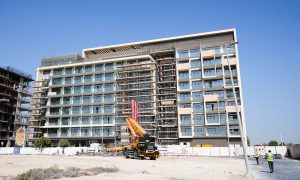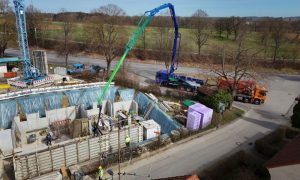“The convergence of digital twins and the Metaverse brings in tools for data generation and behavior prediction”
In the near future cloud-based digital twins will serve predominantly as an asset management environment says Omnix Engineering’s Bhaskar Raman

‘Digital twins’ and ‘Metaverse’ are the buzzwords of the moment in the regional construction industry, as part of wider discussions about digitalisation. While most companies see the potential of these technologies and are keen to talk about them along with their digital journeys, the adoption and rollout of these potentially game-changing technologies has been slow.
“Recent times have established that digitalisation is an essential approach for organisations to stay relevant in today’s world. However, despite the many benefits of digital twins and Metaverse in the construction sector, digital twin technology has been slow to take off in the region,” reveals Bhaskar Raman, Regional Business Unit Head at Omnix Engineering in an exclusive conversation with Middle East Construction News (MECN).
“It is only recently that the understanding and implementation of such technologies is gaining momentum. Besides, for all stakeholders to invest into such technologies remains a challenge as they have to be embedded within traditional business models.”
Raman notes that the willingness to adapt any new technology is a real barrier to contend with but notes that adoption has begun. He explains, “It took almost a decade for BIM to be embraced by organisations and today it is used widely in the Middle East. Similarly, the adoption of digital twins and Metaverse has begun on large projects in Saudi Arabia and the UAE as developers and PMOs are seeing huge benefits in adopting latest technologies.”
Asked whether construction industry stakeholders are set up to leverage these technologies and when wide-scale adoption might take place, Raman responds, “The adoption of these technologies is still at an early stage, but we will see them being implemented at a quicker pace in the near future. Due to the advancements in technologies in the construction sector, we are not far from witnessing an integrated ecosystem of site conditions which will have BIM in place, data will be captured by sensors and will be transmitted real-time.”
Big Project Middle East’s Digital Construction Summit is scheduled to take place on 14 September 2022 in Dubai, while the recently launched ME Digital Construction Awards will take place on 25 October 2022.

In recent years, the construction industry has had to contend with many challenges including complex projects, tighter project budgets, staffing and supply chain challenges, rising fuel costs and more. There is also increased emphasis on building sustainably owing to authorities across the region stepping up their focus on sustainable development.
Posed whether digital twins and the Metaverse can be the game changer companies need to remain competitive and deliver projects to budget and on schedule, Raman says, “Digital twins technology can provide information on building performance and how it is being affected by an occupant. Although the concept of digital twins is relatively new in the construction sector, it has several applications that have the potential to change the way construction projects are managed. Digital twin technology improves access to BIM models and the data collected helps monitor projects on an ongoing basis. Thus, costly mistakes can be avoided.”
“The convergence of digital twins and the Metaverse also improves collaboration and monitoring, bringing in advanced tools for data generation and behavior prediction. Real-time tracking and sensors can improve safety and be used in scaffolding in critical areas. They also enable users to make predictions in unpredictable scenarios while constantly optimising their operational performance.”
“Use of these technologies will make it simpler to access projects and discuss issues or tackle problems in the early stages. These technologies are certainly not limited to a single development and the same model can incorporate waste, water, transport or energy, integrating every aspect of the built environment. By implementing multiple digital twins, a connected ecosystem or ‘smart city’ can be developed,” he adds.
Delving deeper into margins and project budgets and when construction firms will be able to see a return on their investment into digital twins and the Metaverse, Raman remarks, “Construction project budgets have always faced challenges such as inadequate risk management, lack of IT structure, poor co-ordination and communication, unrealistic expectations and forecasting which puts pressure on stakeholders. Most importantly, limitations in skilled workforce and delayed cash flows are issues that need to be dealt with.”

“Construction of a digital twin asset will help resolve many of these issues. Construction firms which have seen the benefits of these technologies are evaluating the software and hardware which are one of the key factors involved in these implementations. With current innovative solutions, the learning curve for using these technologies is short as it is simply an extension of gaming with no coding and programing involved, except for the core domain knowledge. Implementation on a single project will demonstrate visible results within a team,” he clarifies.
Discussing good examples of where digital twins and Metaverse implementations can make an impact in the regional built environment, he points out, “A digital twin is a living asset and will be as important as the physical asset for data collection and to study the behavior of the asset and the occupant. This data is relevant for operators, facility mnagement teams, real-estate brokers and owners.”
He elaborates, “A digital twin simulates not only the design and manufacture of a product, but also how the product will perform throughout its lifecycle. The promise of digital twins is that it will help simulate plans or build what-if scenarios for the products, facilities as well as processes that could be altered before one puts real-world resources behind the actual implementation. Many businesses and industries are taking advantage of this promise. Digital Twins are being utilised to improve ongoing operations, to train employees and to test new products or procedures before launching them in the real world where it becomes more expensive and complicated to fix any issues.”
Asked about how the Metaverse can gain a foothold and make an impact given that, in the post-pandemic era, many individuals and companies have made clear their appetite for real world operations and experiences, he explains, “Post pandemic, organisations have adopted hybrid work models and even though in-person meetings are still preferred, online virtual meetings have taken over as businesses have realised the benefits of the current communication trends. We believe the pandemic has made us more receptive to the digital world. Globally, there are 4.80bn internet users which is 61% of the world’s population. Hence, Metaverse is only the next disruptive technology in all sectors.”
Discussing if there’s any new technology that could potentially disrupt the construction sector in a significant way in the near future, Raman comments, “The digitalisation journey does not end with project delivery. Data collected from the integrated workflows and information sharing on BIM models used during the design and construction process can be layered with real-time operational data to create a digital twin of the development.”
“We will see a two way communication taking place to collect and track data towards the digital twins promise to not only allow project owners and operators to ensure that their assets are running efficiently and safely, but they also ensure that the users have a seamless experience.”

He concludes, “As such, it has been impossible to prevent the intertwining of AR and VR into digital twins and, doing that at scale will be a major accomplishment. This is where the real value of digital twins will start to shine through, fueling more advanced use cases. In the coming days cloud-based digital twins will serve predominantly as an asset management environment. This is essentially a hub for storing, accessing, visualising, and analysing equipment performance data, allowing for non-hierarchical grouping of sensors and their data in near real time.”






















